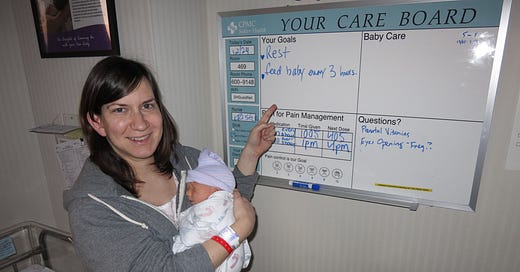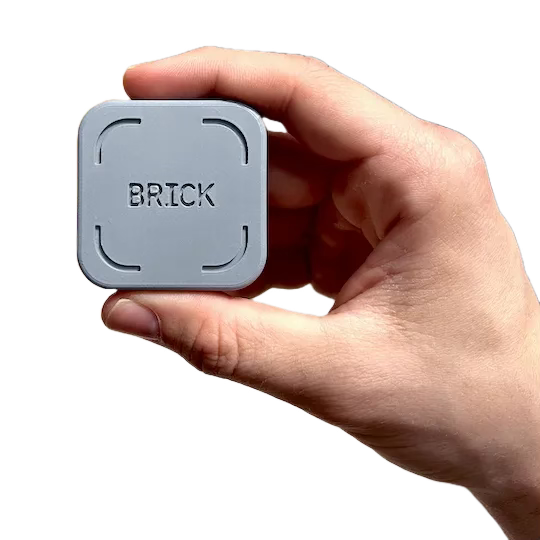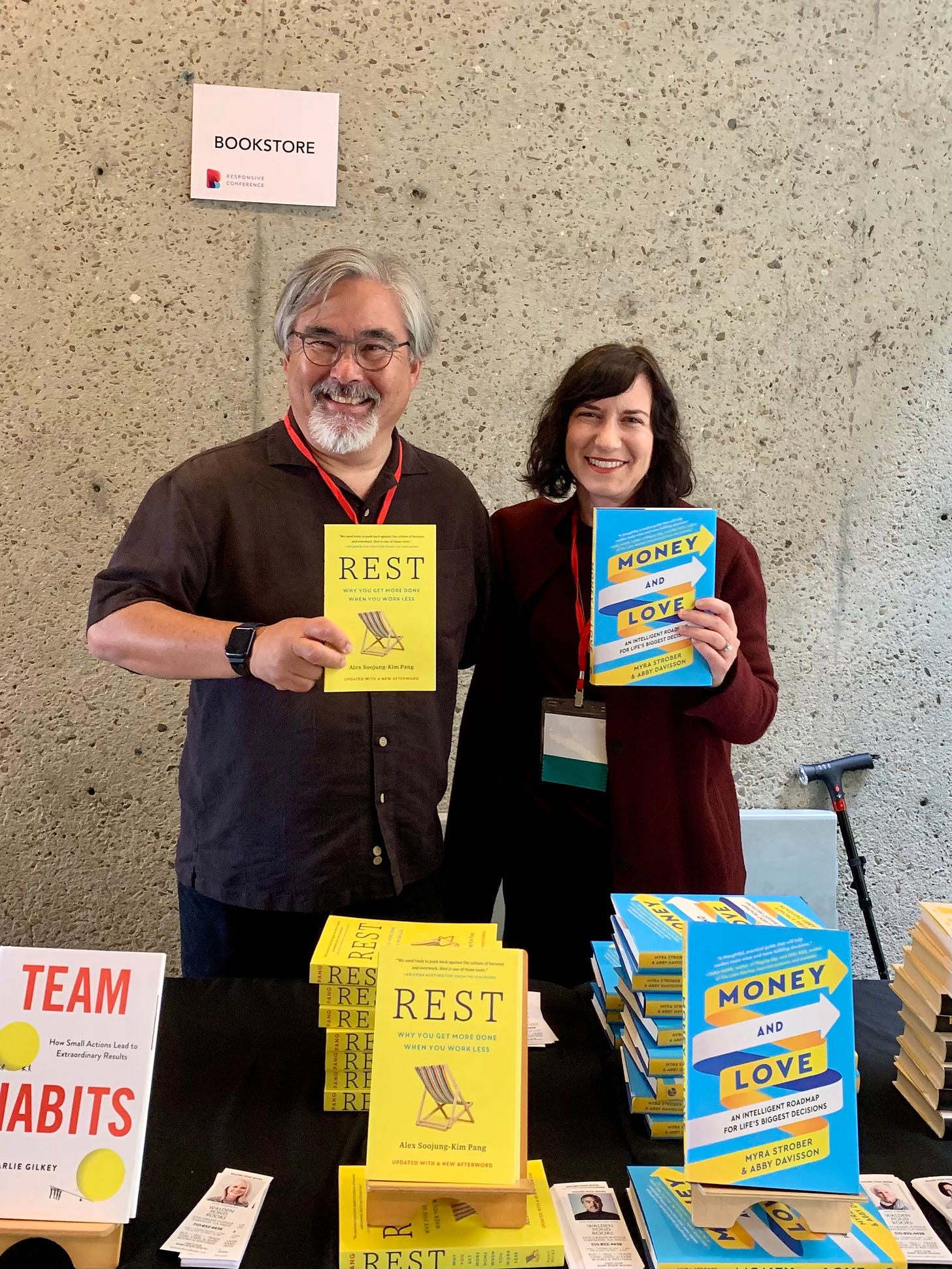One year ago, I launched this newsletter by sharing how a book by Alex Soojung-Kim Pang called Rest: Why You Get More Done When You Work Less had completely changed my perspective.
In that very first edition of Practically Deliberate, I reported:
“Pang argues that we’ve been thinking about rest all wrong. Instead of seeing rest as work’s competitor - something that gets in the way of work - we should be appreciating it as work’s ally. Rest helps us be more creative, productive, and efficient at our work.”
The book not only changed my mind, it altered my approach; I immediately baked deliberate rest into my newly-incorporated company’s operating plan.
In this edition (a 9 minute read), you’ll learn:
How I’ve embraced deliberate rest over the past year
The go-to move that helped me break a decades-long bad habit
My results — and my family’s take on what’s changed from their POV
Want to cultivate your own deliberate rest practice but not sure where to start? Paid subscribers will receive a bonus one-page worksheet with helpful guided prompts (at the end of this newsletter).
But first, if you haven’t yet read that full first post, I recommend checking it out here:
My approach, then and now
My work habits and behaviors were forged by decades of intense school environments (Yale, Stanford Business School) and intense work environments (management consulting followed by jobs with former management consultants).
Suffice it to say that my approach to work over the first 2+ decades of my career was, well, intense.
Work was the clear priority, and life fit around work. Here are a few examples of what that looked like for me in my 30s and 40s:
When my mom fell in 2011, landing in the ICU with brain swelling and bleeding, I flew across the US to be with her and my dad, responding to work emails from her hospital room. When it became clear after a few days that she had a long stay ahead of her, I flew back to SF and returned to the office. Later that month, when my mom had stabilized (but was still in the hospital), I flew to Portland to help run an annual work conference. Weeks later, Ross and I moved into a new home.
When our first son was born the following year, he came 2 weeks early. Because I’d planned to take just 2 weeks off before my due date, I had him on my last scheduled day of work. I’d also been interviewing for a new job in the weeks leading up to his birth. I accepted that job the day before he was born and started 12 weeks later.1
When my mom died in 2020, my then-boss sent me a kind note saying “take as long as you need.” When I asked HR about the formal bereavement policy, I learned there wasn’t one. At the time, I was leading the Gap Foundation, and a board meeting was scheduled for a few weeks later. I attended my mom’s funeral (via Zoom, because 2020) and burial (in person), took one week off, and returned to prep for the board meeting — which then ended up getting cancelled.
If you’re wincing as you’re reading this, know that I am, too — these moments were hard to relive. But here’s the thing: while my managers and colleagues at the time were (mostly) kind and understanding, I truly felt I couldn’t take more time off.
I imagine many knowledge workers in America have felt the same way and have stories similar to mine (and we’re the privileged ones, mind you; hourly workers have more horrifying stories).
Here’s my hot take: most American workplaces today are not wired to accommodate the needs of employees outside of work. And most American employees today are not wired to expect our employers to accommodate our daily needs, let alone our needs when we experience lifequakes like the ones described above.2
Cut to last year — my first as a business owner. As a new entrepreneur, the temptation was strong to double down and work even harder (Founder Mode, anyone?).
But I knew I was at a choice point: I could continue to perpetuate the conditions that caused me to get shingles before my 40th birthday (yes, that actually happened), or I could try a different approach.
So instead of pushing myself to work ALL THE TIME, I gave myself permission to lean into what I needed. I also wrote about it in Practically Deliberate. My year included:
Wintering when I felt grief tap me on the shoulder
Attending a meditation retreat instead of a goal-setting workshop
Finding ways to show up for family even when work beckoned
Leaning into “Summer Abby” and using my travel recommendations
Interestingly, when I paid attention to what I needed, my year ended up being shaped by the rhythms of the seasons much more than it had in years past.
I was reminded of the distinction between ‘Horticultural Time’ (based on nature, more organic) and ‘Industrial Time’ (based on the clock, more precise).
I first encountered this concept in a class Ross and I took when we were expecting our first child (ironically, to illustrate that since babies operate on Horticultural Time, due dates are at best approximations — ahem, lesson learned).3
This past year, I let myself relax into Horticultural Time more than I have in decades — for example, not rushing my grief when it showed up — and it felt right.
The power of commitment devices
It hasn’t been easy to unlearn decades of conditioning overnight. I was quick to be convinced about the value of deliberate rest; putting it into practice has been more of a challenge.
What’s helped me reshape my approach the most is finding the right commitment device for each deliberate rest habit I want to cultivate. I don’t rely on willpower; instead I rely on external assistance to help me stick to my desired behaviors.
Here are some deliberate rest habits I’ve embraced over the past year, along with the commitment devices I employ to keep me on track:
I want to explore the first habit above (related to checking email) because I suspect I’m not alone in this challenge.
First, some context about my relationship to email. Ever since I got my first work Blackberry in 2004, I’ve checked my email shortly after getting up in the morning (before you judge: no, I don’t keep my phone in my bedroom).
This habit got reinforced big time during my nine years at Gap Inc., when the emails started flowing early (I was on a global team, and over the years, I reported to various managers on Eastern Time). It’s pretty ingrained at this point.
After my mid-January meditation retreat, I resolved to meditate consistently. So far I’ve managed a 10-minute session on 249 of the last 250 days (I missed a day when we came back from Spain — I blame the time change).
Deliberate rest, check! Right?
Almost.
I use the Insight Timer app to meditate, which means my phone is always next to me. I developed a bad habit of — you guessed it — checking my email immediately after meditating…and then going down a rabbit hole of checking other apps. Sometimes — this is embarrassing to admit — I’d get sucked into my phone for longer than I’d actually meditated.
Not awesome. But not entirely unexpected, either, given my decades-long habit of checking email shortly after getting up.
I tried telling myself not to do anything on my phone except use Insight Timer, but you can imagine how well that worked.
Enter my new favorite commitment device: the Brick, which I learned about from my friend
in her post titled Need a Break From Your Phone? Soon after I read it, I saw Catherine in person and she showed me the first two devices she reviewed. I promptly bought my own Brick (using her discount code: CATHERINEPRICE for 10% off). Here’s what it looks like:The Brick takes a little while to set it up (you have to tell it which apps to allow and which ones to block), but once that’s done, it couldn’t be easier to use.
Now I tap my phone to the Brick before plugging it in at night, blocking all apps except Insight Timer. I get up, meditate, and can’t check my email (or anything else) until I tap my phone to the Brick again...which I often don’t do until I get back from dropping my kids off at school.
Voila! Commitment device for the win.
What commitment devices do you rely on to cultivate your desired habits? I’d love to hear about them in the comments.
My results
Here’s what I’ve observed over the past year (I also asked my family to weigh in):
I’m healthier: My health app tells me I’m taking more steps/day than last year (thanks, tennis!). Since I live with
germ vectorsyoung kids, I still get sick, but I bounce back more quickly than I used to.I have more energy: Ross told me that he’s seen me more energized by my work this past year. As a fellow entrepreneur, he knows that the highs are higher and the lows are lower on this path, but overall, I wake up excited to tackle each day.
I’m more present: My kids told me that while I still work a lot (and still get stressed), they perceive that I’m “around more” and have “gone on more trips” with them. This is objectively true!
I’m more creative: In addition to doing paid speaking, I launched this newsletter and published 27 posts over the last year. I also launched a cohort-based course (which I’ll teach again in Spring 2025) and a coaching practice.
Speaking of creativity, I recently got a chance to engage in a creative collaboration with Alex Pang, the author of Rest (that’s us below).
We spoke at a conference together about redefining rest and rebuilding your career, which inspired some of the reflections I shared in this newsletter.
For our session, I developed a one-page worksheet to help attendees consider how to apply deliberate rest to their own lives. Afterwards, a friend who joined told me she overheard someone say, “I really needed this.”
Paid subscribers can access the worksheet by clicking on the link below.
Feel free to upgrade your membership to access the worksheet (or just to say happy birthday to Practically Deliberate).
Thank you for reading and cheers to what’s ahead.









